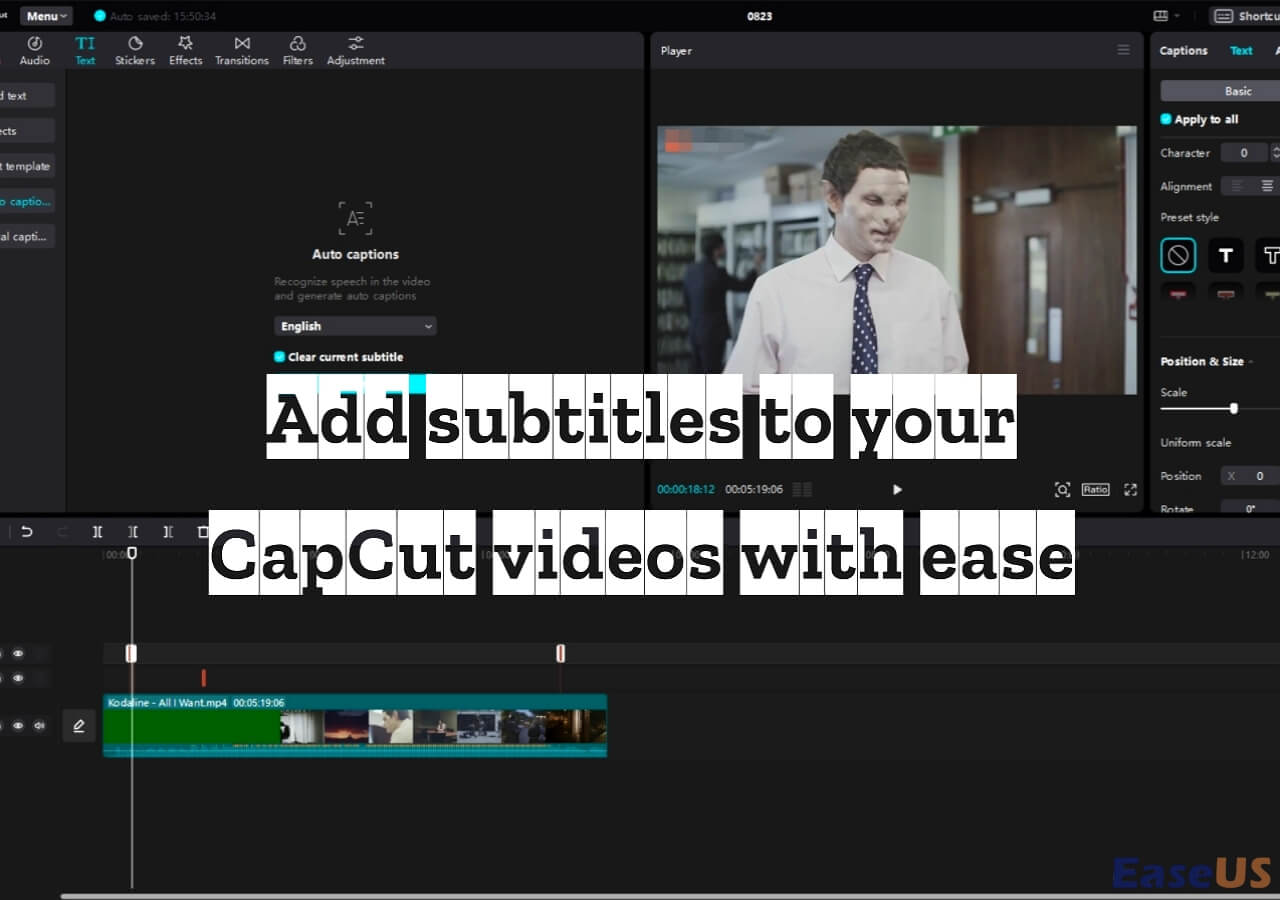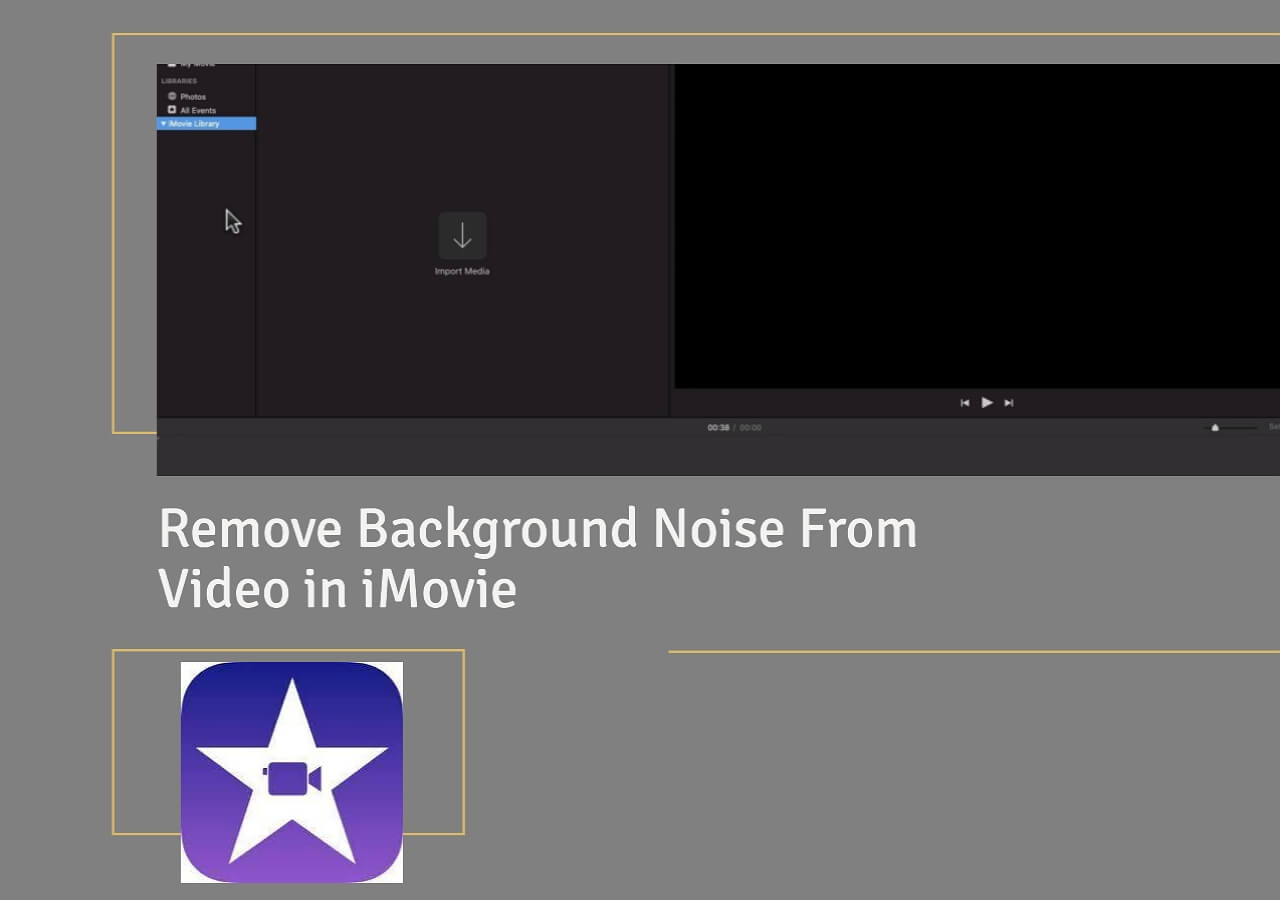-
![]()
Sofia Albert
Sofia has been involved with tech ever since she joined the EaseUS editor team in March 2011 and now she is a senior website editor. She is good at solving various issues, such as video downloading and recording.…Read full bio -
![]()
Melissa Lee
Melissa Lee is a sophisticated editor for EaseUS in tech blog writing. She is proficient in writing articles related to screen recording, voice changing, and PDF file editing. She also wrote blogs about data recovery, disk partitioning, data backup, etc.…Read full bio -
Jean has been working as a professional website editor for quite a long time. Her articles focus on topics of computer backup, data security tips, data recovery, and disk partitioning. Also, she writes many guides and tutorials on PC hardware & software troubleshooting. She keeps two lovely parrots and likes making vlogs of pets. With experience in video recording and video editing, she starts writing blogs on multimedia topics now.…Read full bio
-
![]()
Gorilla
Gorilla joined EaseUS in 2022. As a smartphone lover, she stays on top of Android unlocking skills and iOS troubleshooting tips. In addition, she also devotes herself to data recovery and transfer issues.…Read full bio -
![]()
Rel
Rel has always maintained a strong curiosity about the computer field and is committed to the research of the most efficient and practical computer problem solutions.…Read full bio -
![]()
Dawn Tang
Dawn Tang is a seasoned professional with a year-long record of crafting informative Backup & Recovery articles. Currently, she's channeling her expertise into the world of video editing software, embodying adaptability and a passion for mastering new digital domains.…Read full bio -
![]()
Sasha
Sasha is a girl who enjoys researching various electronic products and is dedicated to helping readers solve a wide range of technology-related issues. On EaseUS, she excels at providing readers with concise solutions in audio and video editing.…Read full bio
Content
How to Install Spleeter
How to Use Spleeter to Separate Audio Tracks
Bonus: Easy Online Way to Separate Music Tracks
The Bottom Line
FAQs on Spleeter
1507 Views |
3 min read
Music source separation can be a tricky process, and it can take a while. Many tools allow users to do this; some claim to do it more efficiently than others. There are various AI programs with trained models that push this separation and make it easy for users.
That's when Spleeter by Deezer stands out as a good tool for a lot of users. This remarkable tool allows users to create multiple tracks from a single/flat audio file, i.e., separate vocals from instrumental easily. So, the user can employ said audio files in various ways, be it for music, games, movies, etc.
So, what exactly is this pre-trained and open-source program? How do you install it on your PC and use it? We'll show you everything and tell you how to get the source separation tool to make acapella from a song or anything else you like. So, let's get started.
How to Install Spleeter
Many consider Spleeter to be a vocal remover app, but others call it a complete package for source separation. Now, how you want to use it depends on your need, i.e., if you're going to remove bass or vocals from a music file.
So, the only way to let Spleeter separate sources in an audio file is by installing it. So, let's show you how to get this open-source program through CMD commands. Here is the entire procedure, and all of the steps, like conda install and using Spleeter 2stems, are mandatory:
Step 1. Go to Microsoft Store, then search "Python 3.8" and install it.

Step 2. Now let the installation finish and wait for the Command Prompt window to show up.
Step 3. Type this command in the CMD "pip install ffmpeg-python" and press enter.

Step 4. Now type "pip list -v," and press enter to begin adding Python scripts to the Environment Variable.

Step 5. Copy the FFMPEG-python directory.

Step 6. Now press Windows + E, then paste it into the Explorer to go to directory.

Step 7. Now copy the "Scripts" folder address/path from that location and save it (Notepad/Word).

Step 8. Open "System Properties" by right-clicking on the "This PC" icon.
Step 9. Now head into the "Environment Variables" option.

Step 10. Now tap on the "Path" option and tap the "Edit" button.
Step 11. Under the "Edit" options, tap on "New" to paste the address/path to the Scripts folder.
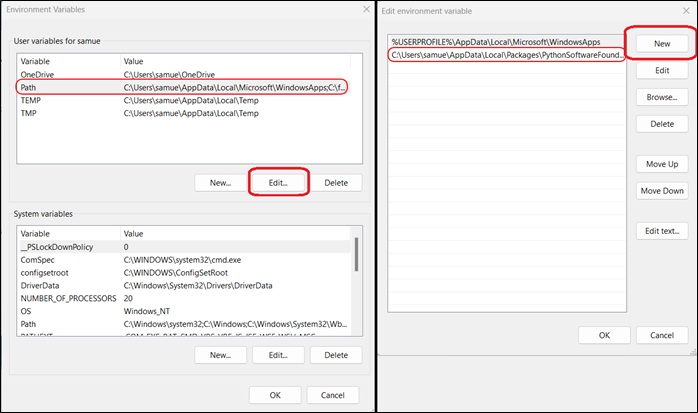
Step 12. Go back to CMD to install Spleeter now.
Step 13. Type the pip install command like this: "pip install spleeter==2.0".

Step 14. Wait for the installation to finish.

Once you are done, the program will be installed, but it'll only be used by employing the primary command line(s) that it offers. You can check the rest of them on Github.com and find more information on this trained state-of-the-art model for source separation.
How to Use Spleeter to Separate Audio Tracks
Once you have the source separation tool, it'll be easy to use it and separate elements of an audio file from the source. The process is simple but requires you to save or copy audio files into a folder that can be easily accessed, like the Windows' default Music folder.
Simply copy any file then paste it into this folder, and then use Spleeter to separate audio tracks. Here's how the process unfolds in real time:
Step 1. Copy and paste a music file into the "Music" folder.

Step 2. Now open CMD and type "cd Music" to go into the folder.
Step 3. Now type this command to begin source separation.
“Spleeter separate -i audio_example.mp3 -p spleeter:2stems -o output”

Step 4. Wait for the separation to finish.

Step 5. Now check the "Output" folder in the Music folder to see the separated files.

In "Step 3," make sure you replace the file name, aka "Audio_example.mp3", with the name of your audio/music file. And yes, you do have to add the extension, i.e., ".mp3", at the end of the file name. So, make sure you follow each of the steps thoroughly in order to separate audio tracks with Spleeter.
Bonus: Easy Online Way to Separate Music Tracks
There are easier ways to separate music tracks than going through the hassle of Steeper. This accessible online way allows you to remove background noise without any fuss and get the audio separation that you need.
The tool is called EaseUS Online Vocal Remover and it has all the features you could need to separate the source/elements of a music file. What can you do with this tool besides vocal removal? Here are some key features:
- You can easily separate instrumentals in high-quality;
- Use a Stem Splitter for easy stem separation;
- Use the noise reducer to improve the quality of audio files;
- Change the pitch of any music file you like;
- Find BPM with the in-built BPM finder.
You can access this tool from here.
That's why it's a more effortless and better alternative to Spleeter, and you should try it. Simply go to the EaseUS Online Vocal Remover website and upload the file. Here's how:
Step 1. Access the website and move to the "Stem Splitter" tab.
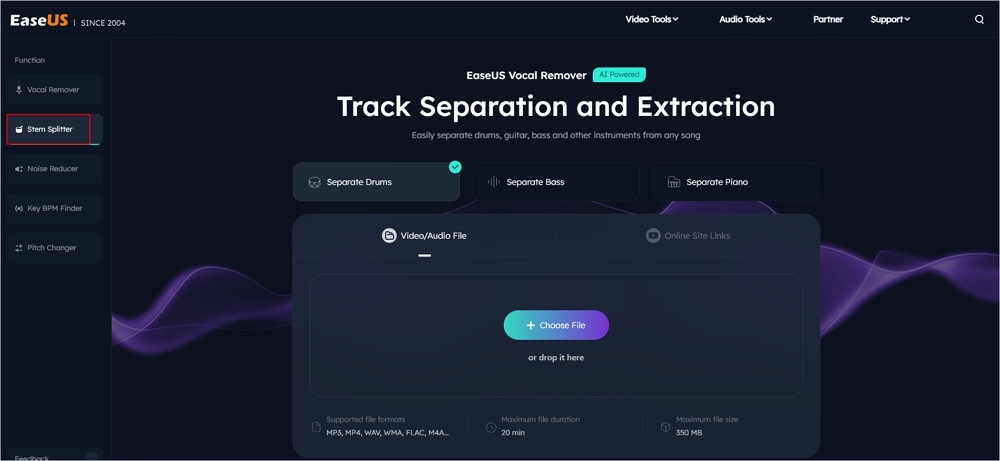
Step 2. Select which instrument to separate and click "Choose File" or drop the file in the area and wait for seconds.
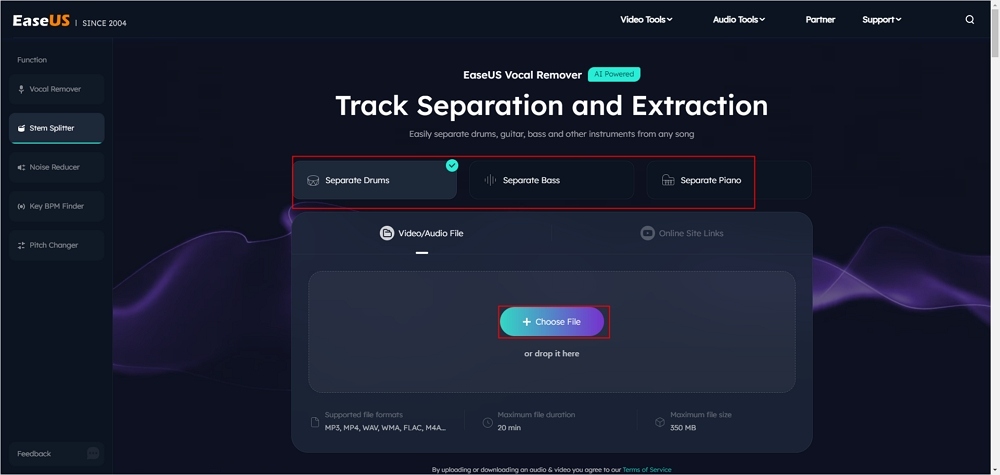
Step 3. Download the song with specific instrument removed.
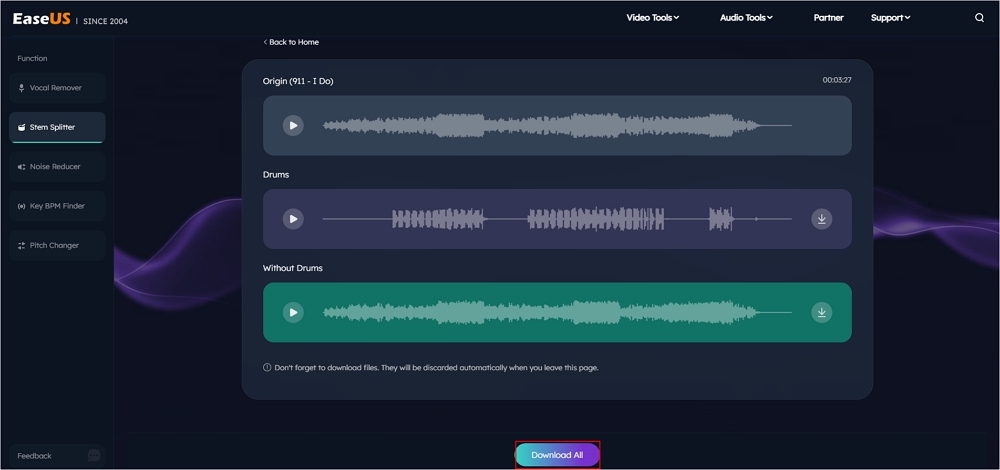
The Bottom Line
There you have it—all the things you need to know about Spleeter. We talked about the installation process and how you can use it to separate the source of an audio file. It's pretty straightforward, though the steps can be a bit overwhelming.
That's why, if you're looking for a more straightforward solution, you can use EaseUS Online Vocal Remover again. This program allows you to do the same without any installation. Simply upload your file into the tool, and then use the options that it provides to separate the sources.
FAQs on Spleeter
Here are some additional questions that people ask regarding Spleeter and their answers with thorough explanations:
1. What does Spleeter do?
Spleeter is used for creating multitracks from a single/flat audio file. It can help creators separate specific parts of a music or general audio file and then use it for content creation. Deezer's own website says that it's ideal for those looking to separate audio file sources for games, movies, podcasts, etc.
2. Is Spleeter free?
Yes, Spleeter is a free and open-source program. It uses TensorFlow and employs the basics of Python to execute commands. That's why it doesn't have a general UI like other tools, and you need to operate CMD to be able to use this.
3. What is better than Spleeter?
Spleeter is excellent, but it isn't exactly for the typical user. The commands and complications of installing it can be a bit much for everyday users. That's why EaseUS Online Vocal Remover is a better alternative. It's easier, simpler, and doesn't require you to install it to use it.
If you find this article helpful, then share it with someone who might need to know more about Spleeter.

